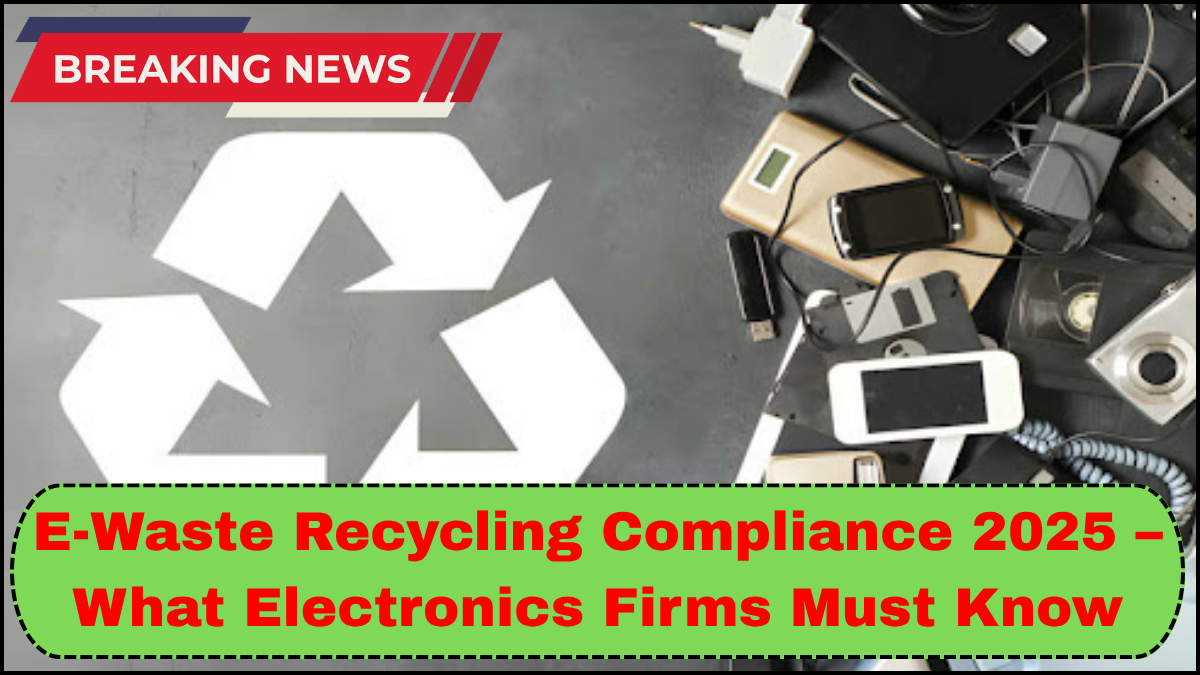As the global demand for electronics continues to surge, so does the environmental burden of discarded devices. Recognizing the urgency, regulators are tightening the framework around e-waste, with E-Waste Recycling Rules 2025 ushering in a new era of accountability for manufacturers. For electronics firms, adapting to these changes isn’t optional—it’s essential for compliance, reputation, and long-term viability.

Here’s a breakdown of what’s changing and what electronics companies need to prepare for.
Understanding the New E-Waste Recycling Rules 2025
The E-Waste Recycling Rules 2025 build on previous frameworks but introduce more stringent requirements across the board. The rules mandate higher recycling targets, expanded responsibilities for producers, and stricter tracking of electronic waste through its lifecycle.
Key features include:
-
Increased Collection Targets: Electronics producers must meet ambitious collection quotas based on the quantity of products sold in previous years. These targets are now calculated with more precision and must be met annually.
-
Expanded Producer Responsibility (EPR): Companies are now legally obligated to ensure their products are collected and recycled responsibly. EPR plans must be submitted and approved before new products hit the market.
-
EPR Credits and Penalties: Firms can earn compliance credits for exceeding targets or purchasing credits from over-compliant producers. Failure to meet quotas can result in heavy fines or even restrictions on market access.
-
Digital Waste Tracking: All e-waste must be logged in centralized government systems. This includes tracking from collection points to final recycling or disposal facilities, ensuring transparency and accountability.
New Compliance for Electronics Firms: What’s Required?
The new compliance for electronics firms goes beyond ticking boxes. It demands active participation in the circular economy, with changes in production, logistics, and post-consumer engagement.
1. Compliance Documentation and Reporting
Firms must maintain detailed records of product sales, collection efforts, recycling partnerships, and material recovery. All this data must be submitted quarterly to designated compliance authorities.
2. Collaboration with Authorized Recyclers
Only government-approved e-waste recyclers can be used under the new framework. Firms must form partnerships, verify certifications, and conduct audits to ensure recyclers are not illegally exporting or dumping e-waste.
3. Sustainable Product Design
Regulations now encourage companies to design products that are easier to disassemble and recycle. This includes labeling parts with material information and reducing the use of hazardous substances.
4. Consumer Awareness Campaigns
Electronics brands are required to run public awareness campaigns about safe e-waste disposal. This includes digital ads, labels, and packaging content that inform users how and where to return old devices.
Preparing for 2025: Strategic Steps for Electronics Firms
Audit Your Current Compliance Status:
Start with a gap analysis. Identify areas where your current processes fall short of the E-Waste Recycling Rules 2025 and prioritize those for immediate action.
Update Your EPR Plans:
Revise your Extended Producer Responsibility strategy to meet new targets and incorporate partners that can support reliable collection and recycling.
Invest in Traceability Tools:
Implement software and IoT solutions to monitor product returns and waste tracking. This tech can automate reporting and reduce the risk of non-compliance.
Train Internal Teams:
Ensure that your compliance, logistics, and customer service teams understand the new compliance requirements. Internal missteps are a leading cause of regulatory failures.
Engage Early with Regulators:
Proactively communicate with local and national authorities. Early submission of documentation and feedback requests can reduce compliance risks.
Why This Matters: Risks and Opportunities
Ignoring the E-Waste Recycling Rules 2025 carries significant consequences, including fines, import/export bans, and damage to brand reputation. On the flip side, early adopters stand to benefit from cost efficiencies, brand trust, and investor interest in ESG (Environmental, Social, and Governance) practices.
Forward-looking companies are using compliance as a differentiator—investing in modular designs, in-house recycling labs, and customer return incentives.
Frequently Asked Questions (FAQ)
Q1: What are the penalties for non-compliance with E-Waste Recycling Rules 2025?
A: Penalties include monetary fines, loss of EPR authorization, restrictions on new product launches, and in severe cases, legal action or shutdown of operations in certain jurisdictions.
Q2: Can small electronics firms apply for exemptions?
A: While some micro enterprises may receive relaxed targets, most are still required to register and meet minimum recycling goals. Exemptions are granted on a case-by-case basis.
Q3: Are international electronics brands subject to these rules in local markets?
A: Yes. Any brand selling electronics in a jurisdiction covered by the E-Waste Recycling Rules 2025 must comply, regardless of where the company is headquartered.
Q4: How are compliance credits traded?
A: Authorized platforms enable the buying and selling of surplus EPR credits. Firms must maintain proof of transactions and ensure that credits are sourced from verified over-compliers.
Q5: What’s the role of third-party compliance partners?
A: Third-party firms assist in logistics, documentation, and reporting. They can help companies scale compliance efforts efficiently, but the legal responsibility remains with the producer.
click here to learn more



